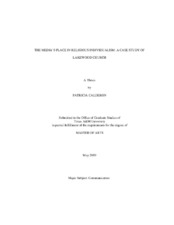| dc.description.abstract | This thesis addresses how the Joel Osteen ministry uses mass media at its Lakewood church, located in Houston, Texas, and at its services around the nation. I studied this ministry?s religious use of media to understand what it communicates about the church or ministry itself. To assist in my analysis, I have applied the concept religious individualism. Herein, this concept describes an individual who sees him- or herself as separate from their Christian community (or affiliation) which stems from a belief in a God who is also directly involved in the lives of individuals. Religious individualism is acted out in four observable characteristics which include: displaying emotion to seek attention, taking personal responsibility for one?s spiritual growth, expecting God?s future blessing, and seeking one?s personal needs in a church above communal needs. I used this definition to determine whether Lakewood illustrated these traits in order to make an inference on how this would inform its use of mass media.
I applied both field observation skills and qualitative content analysis in this study. My own observation was used during my own observation of the Lakewood services, while content analysis was used to analyze blog and newspaper articles covering Osteen-led services. Findings from both methodologies revealed that the Osteen ministry does not merely employ mass media as a tool but integrates it into the very image of the church, making its use necessary and natural. This conclusion was reached as both methodologies showed Lakewood and the Osteen ministry exemplifying each trait of religious individualism. In observance of its religious individualism, it appeared natural for the ministry and church to use media as it helped enforce the importance of each trait to the audience. Likewise, the results from both the field observation and content analysis show that the audience responded to Lakewood?s use of mass media as inseparable from the services. Perhaps paradoxically, it became necessary for the ministry to use mass media to reach an audience that expected to be addressed in a personal way, based on a value of personal needs being met. | en |


